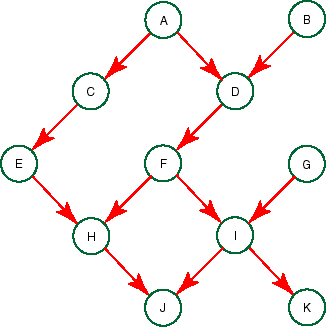
Consider the following belief network:
Assume that all of the variables are Boolean (i.e., have domain {true,false}.
Draw another undirected graph, with the same nodes where there is an arc between two nodes if there is an original factor or a created factor (given the elimination ordering for part (c) that contains the two nodes. Notice how the second graph triangulates the moral graph.
Draw a third undirected graph where the nodes correspond to the maximal cliques of the second (triangulated) graph. [Note that a clique of a graph G is a set of nodes of G so that there is an arc in G between each pair of nodes in the the clique. We refer to the nodes of the Bayesian network/moral graph as variables.] Draw arcs between the nodes to maintain the properties (i) there is exactly one path between any two nodes and (ii) if a variable is in two nodes, every node on the path between these two nodes contains that variable. The graph you just drew is called a junction tree or a clique tree. On the arc between two cliques, write the variables that are in the intersection of the cliques. What is the relationship between the clique tree and the VE derivation?